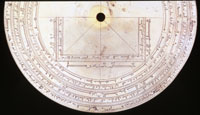Calendrical applications of Islamic astrolabes
 The calendar scales (round the outside edge) on an Islamic astrolabe in the Whipple Collection.
The calendar scales (round the outside edge) on an Islamic astrolabe in the Whipple Collection.
The first rising of the crescent moon marks the beginning of the lunar month; witnesses with exceptional eyesight were sent to observe the rising of the crescent to determine when it was the first day of the month. Problems of visibility compounded the difficulty of seeing the crescent moon as it rose, and calculations were made on the chances of seeing the crescent moon on certain days. This depended on many factors including the relative position of the sun to the moon at sunset on the day the moon was expected to rise. The time of sunrise could be calculated with an astrolabe, as could the position of the sun, and these combined to estimate whether or not the moon would be visible. Almanacs were produced, giving information about the visibility of the crescent during the year, and the method of calculation was refined further. Even though the astrolabe was not the most accurate of the methods for calculating the calendar, it provided an easier way to calculate. The importance of this application of the astrolabe is shown by the inclusion on almost all Islamic astrolabes of detailed calendrical scales.